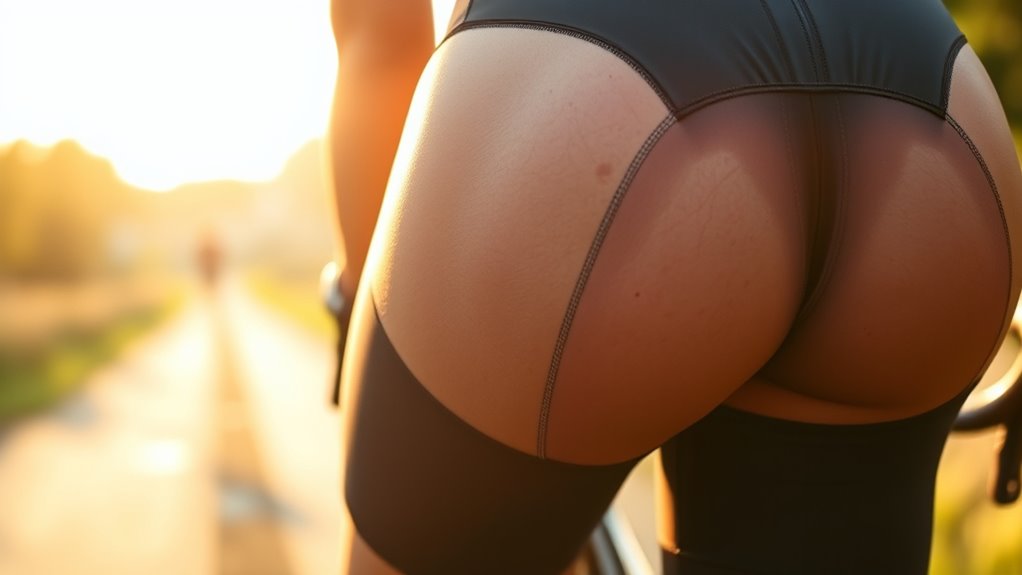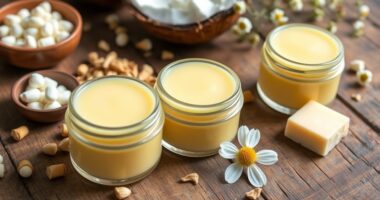To prevent chafing, choose moisture-wicking fabrics like polyester or nylon blends that keep sweat away from your skin. Make sure your clothing fits well—neither too tight nor too loose—to minimize rubbing. Stay well-hydrated before and during activity to keep your skin healthy and resilient. Avoid cotton, which traps moisture, and consider applying anti-chafing balms or powders for extra protection. Continue exploring tips for keeping your skin comfortable during all your activities.
Key Takeaways
- Wear moisture-wicking, properly fitted clothing to reduce skin friction and keep sweat away from the skin.
- Choose technical fabrics like polyester or nylon blends over cotton for better moisture management.
- Stay well-hydrated before, during, and after activity to maintain healthy, resilient skin.
- Avoid tight or loose clothing that can increase friction or cause rubbing.
- Use anti-chafing products such as lubricants or powders to create a protective barrier on the skin.

Chafing can be uncomfortable and even painful, but with the right prevention tactics, you can avoid this common irritation. One of the most effective ways is to pay attention to what you wear. Choosing moisture wicking fabrics is essential because they pull sweat away from your skin, reducing friction and preventing chafing. These fabrics dry quickly, helping you stay dry and comfortable during physical activity or hot weather. Avoid cotton clothing, which tends to trap moisture and exacerbate chafing. Instead, opt for technical fabrics designed for active wear, such as polyester or nylon blends, which are specifically engineered to manage sweat and keep your skin dry. Proper fit also matters—clothes that are too tight can increase friction, while loose clothing can cause chafing by rubbing against your skin. Find a balance by selecting well-fitting, moisture-wicking garments that stay in place without constricting movement.
In addition to clothing choices, maintaining proper hydration is indispensable in preventing chafing. When you’re well-hydrated, your skin stays healthy and resilient, less prone to irritation. Drinking plenty of water helps regulate your body temperature and reduces excessive sweating, which is often a culprit behind chafing. Remember to hydrate before, during, and after physical activity, especially if you’re exercising in hot or humid conditions. Proper hydration also promotes the natural lubrication of your skin, decreasing the likelihood of chafing caused by dry or irritated skin. Keep a water bottle handy and sip regularly to stay ahead of dehydration, which can make your skin more vulnerable to friction and irritation. Additionally, understanding projector compatibility with your active lifestyle can help prevent discomfort caused by improper gear selection during outdoor activities.
Frequently Asked Questions
Can Chafing Occur During Cold Weather?
Yes, chafing can occur during cold weather. When you wear thermal insulation and moisture management clothing, it helps keep your skin dry and reduces friction. Even in chilly conditions, sweat can build up, causing chafing if your clothing doesn’t wick moisture away effectively. To prevent discomfort, choose proper layers, stay dry, and make sure your clothing fits well. This way, you minimize skin irritation during cold-weather activities.
Are Certain Fabrics More Prone to Cause Chafing?
Certain fabric types, especially rough or stiff ones, are more prone to causing chafing. You should look for moisture-wicking fabrics like polyester or nylon, which help keep your skin dry and reduce friction. Avoid cotton in areas prone to chafing, as it retains moisture and increases irritation. Choosing smooth, seamless clothing made from moisture-wicking fabrics can make a big difference in preventing chafing during your activities.
How Does Hydration Influence Chafing Risk?
Did you know that staying well-hydrated can reduce chafing risks by 30%? Proper hydration directly impacts your skin’s resilience, making it less prone to irritation. When your water intake effects are ideal, your skin stays supple and less likely to chafe during activity. So, drink plenty of water before, during, and after exercise to keep your skin protected and minimize chafing discomfort.
Can Diet Impact Skin Susceptibility to Chafing?
Yes, your diet can impact your skin’s susceptibility to chafing. Nutrition effects, like consuming enough vitamins C and E, promote collagen production, which enhances skin elasticity and resilience. A diet lacking essential nutrients may weaken your skin, making it more prone to chafing and irritation. To protect your skin, eat a balanced diet rich in antioxidants, healthy fats, and hydration, supporting strong, flexible skin that withstands friction better.
What Are Quick Remedies for Chafed Skin?
Think of chafed skin as a battlefield needing quick relief. You can apply aloe vera gel or coconut oil as soothing home remedies to calm irritation fast. Keep the area clean and dry, and wear loose, breathable clothing to prevent further damage. For preventive measures, use anti-chafing powders or ointments and stay dry during activities. These simple steps act like shields, helping your skin heal and stay protected against future chafing.
Conclusion
Think of chafing prevention as tending a garden—you must keep the soil healthy and protected. By choosing the right clothing, staying dry, and applying friction-reducing products, you’re cultivating a resilient environment. When you nurture this care, you create a shield that keeps discomfort at bay, like a sturdy fence guarding your peaceful patch. With consistent effort, you’ll enjoy smoother walks and runs, turning your journey into a well-tended sanctuary where chafing has no place to grow.









